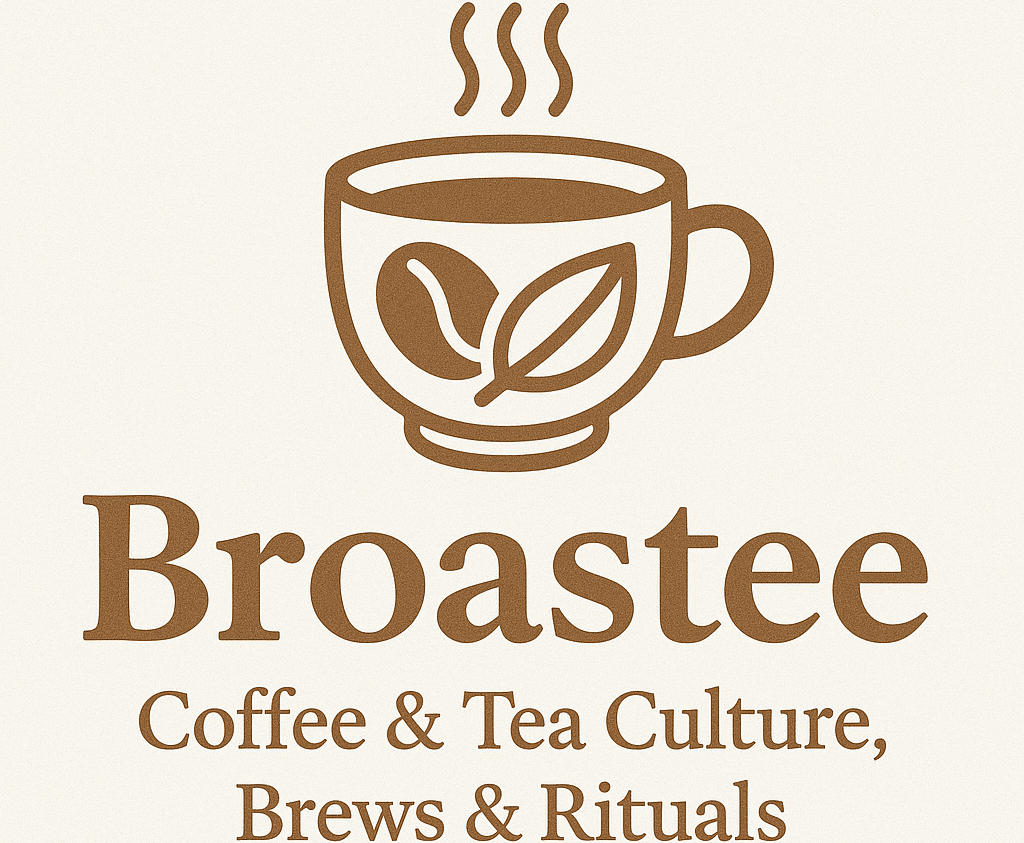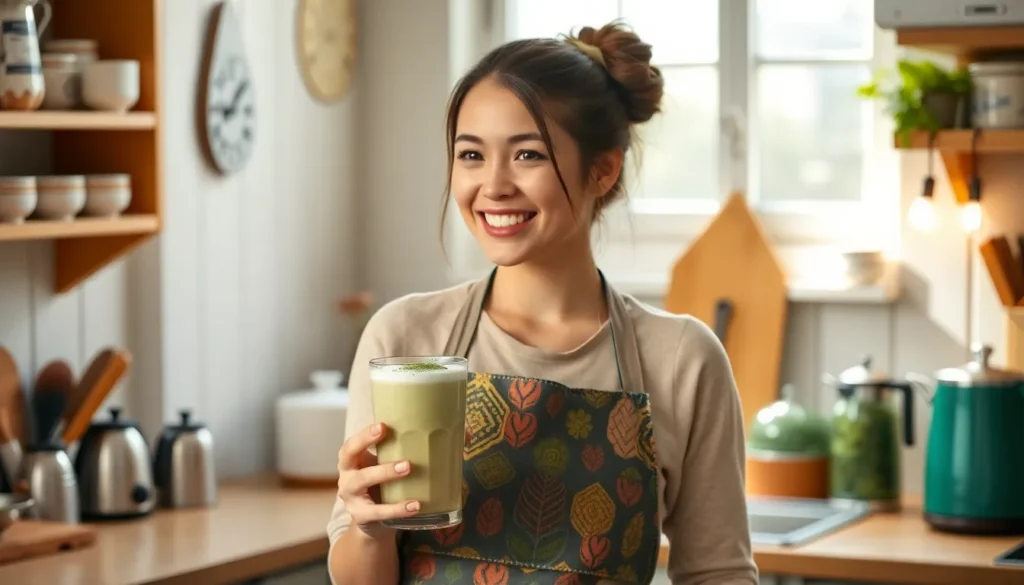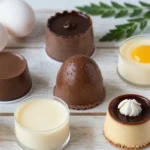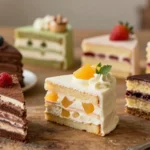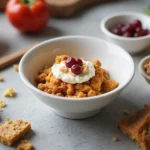We’re about to take you on a delicious journey through the industry of milk tea – that perfect creamy blend that’s captured hearts across the globe. From Taiwan’s iconic bubble tea to India’s spiced chai masala, milk tea has evolved into countless variations that satisfy every taste preference and craving.
What started as a simple combination of tea and milk has transformed into an art form. Whether you’re seeking the rich boldness of Hong Kong-style milk tea, the sweet comfort of Thai iced tea, or the trendy matcha milk tea that’s taking social media by storm, we’ve got the perfect recipes to elevate your home brewing game.
Ready to ditch those expensive café visits? We’ll show you how to create professional-quality milk teas right in your kitchen using simple ingredients and foolproof techniques. These recipes will save you money while delivering that perfect balance of tea, milk, and sweetness you’ve been craving.
Essential Equipment and Tools
Creating exceptional milk tea at home requires the right equipment to achieve that perfect café quality texture and flavor. We’ve compiled a comprehensive list of essential tools that will elevate your milk tea brewing experience from amateur to professional level.
Basic Brewing Equipment
Tea Strainers and Infusers form the foundation of proper milk tea preparation. Fine mesh strainers ensure smooth tea without loose leaves while ball infusers work perfectly for single servings. Bamboo tea strainers offer traditional authenticity and superior filtration for loose leaf teas.
Measuring Tools guarantee consistent results every time you brew. Digital kitchen scales provide precise measurements for tea leaves and ingredients. Measuring spoons and cups help maintain proper ratios between tea and milk components.
Saucepans and Kettles deliver the heat control necessary for optimal brewing. Heavy bottomed saucepans distribute heat evenly and prevent scorching during milk heating. Electric kettles with temperature controls allow precise water heating for different tea varieties.
Specialized Milk Tea Tools
Milk Frothers create that signature creamy texture found in professional milk teas. Handheld electric frothers work excellently for small batches while French press plungers double as effective milk aerators. Steam wands from espresso machines produce café level milk foam for premium results.
Blenders and Shakers become essential for bubble tea and mixed milk tea varieties. High speed blenders crush ice and blend ingredients smoothly. Cocktail shakers create proper mixing for cold milk tea preparations and ensure ingredient integration.
Storage and Serving Equipment
Glass Containers preserve tea freshness and allow visual inspection of brewing progress. Mason jars work perfectly for cold brew preparations and storage. Clear measuring cups help monitor milk ratios during preparation.
Serving Accessories enhance the final presentation and functionality. Wide straws accommodate tapioca pearls and other add ins. Tall glasses showcase layered milk tea creations while insulated tumblers maintain temperature for extended enjoyment.
| Equipment Category | Essential Items | Optional Upgrades |
|---|---|---|
| Brewing Basics | Fine mesh strainer, measuring cups | Temperature controlled kettle |
| Milk Processing | Handheld frother, saucepan | Steam wand, high-end blender |
| Storage | Glass jars, measuring containers | Vacuum sealed containers |
| Serving | Tall glasses, wide straws | Insulated tumblers, decorative cups |
Electric Equipment Considerations streamline the milk tea making process significantly. Automatic tea makers brew consistent batches while electric milk steamers create professional texture. These investments pay dividends for frequent milk tea enthusiasts who value convenience and consistency.
Quality Materials make a substantial difference in final results. Stainless steel equipment resists staining and maintains hygiene standards. Glass components allow visual monitoring of brewing progress and ingredient ratios throughout preparation.
Base Ingredients for All Milk Tea Recipes
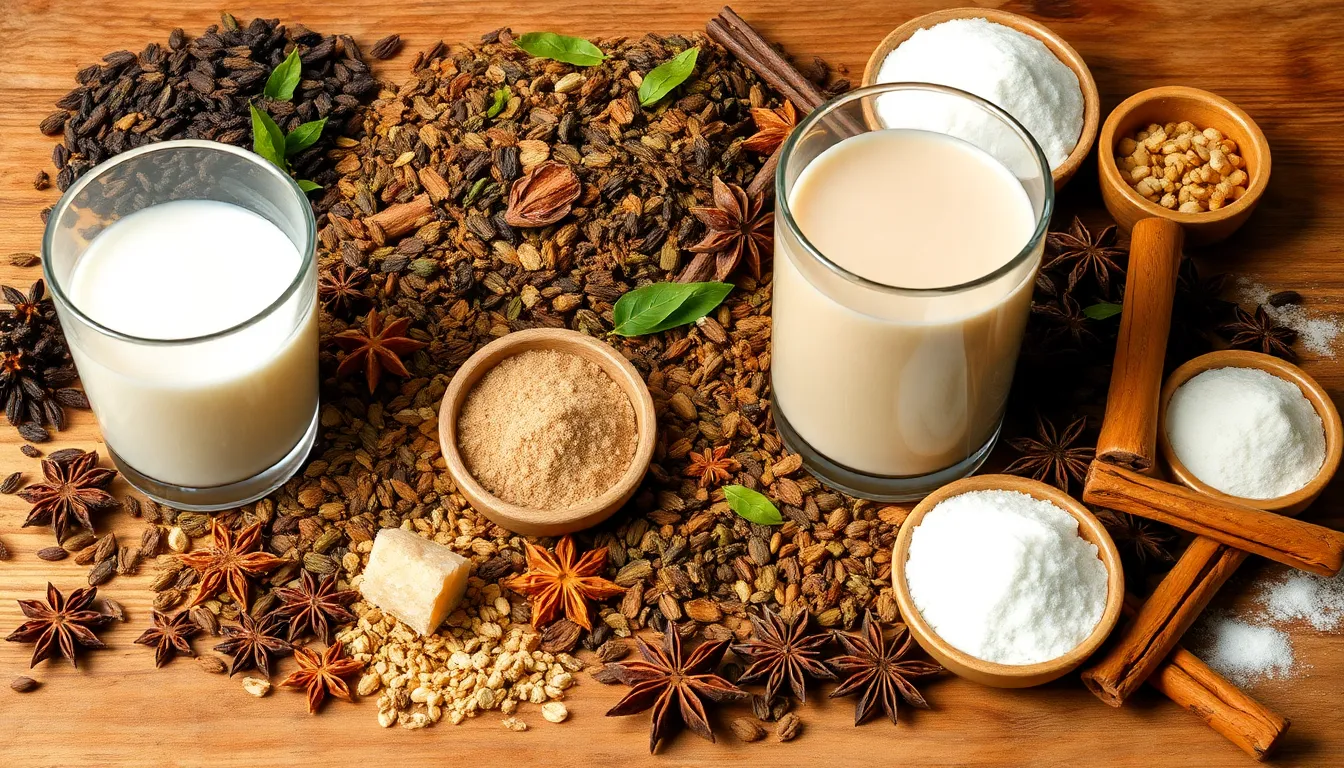
Creating exceptional milk tea starts with selecting the right foundation ingredients. Understanding these core components will help us create consistently delicious beverages that rival professional tea shops.
Tea Bases
We rely on three primary tea types to create the perfect milk tea foundation. Black tea serves as our most popular choice due to its robust flavor profile that stands up beautifully against milk and sweeteners. Ceylon tea offers a smoother alternative with its refined taste that creates particularly elegant milk teas.
Green tea provides a lighter base for those seeking a more delicate flavor experience. When we want to elevate our milk tea with aromatic complexity, spiced ingredients like star anise, cinnamon, or cardamom transform ordinary tea into extraordinary blends.
| Tea Type | Flavor Profile | Best For |
|---|---|---|
| Black Tea | Strong, robust | Traditional milk teas |
| Ceylon Tea | Smooth, refined | Premium blends |
| Green Tea | Light, delicate | Subtle variations |
Milk Options
Our choice of milk dramatically impacts both texture and flavor in every cup. Whole milk delivers the classic creamy richness that most traditional recipes demand. Heavy cream creates an indulgent texture perfect for special occasion milk teas.
Non-dairy alternatives like almond milk and oat milk accommodate dietary preferences while maintaining excellent taste. Each milk type brings its own character to the final beverage, allowing us to customize based on desired creaminess and nutritional needs.
Sweeteners
We select sweeteners based on the flavor profile we want to achieve in our milk tea. Brown sugar adds depth with its rich, caramel-like notes that complement bold tea flavors exceptionally well. White sugar provides clean sweetness without competing with other ingredients.
Simple syrup offers the smoothest integration, dissolving effortlessly into both hot and cold preparations. The sweetener choice influences not just sweetness level but also the overall complexity of our finished milk tea.
Flavor Enhancers
Spices and additional flavorings allow us to create signature milk tea variations. Fresh ginger adds warming heat that pairs beautifully with black tea bases. Mint brings refreshing coolness that works especially well in lighter tea preparations.
Cinnamon contributes warm spice notes that enhance both traditional and modern milk tea recipes. Flavored tea powders offer convenient ways to achieve consistent specialty flavors without extensive preparation time.
Classic Black Milk Tea Recipe
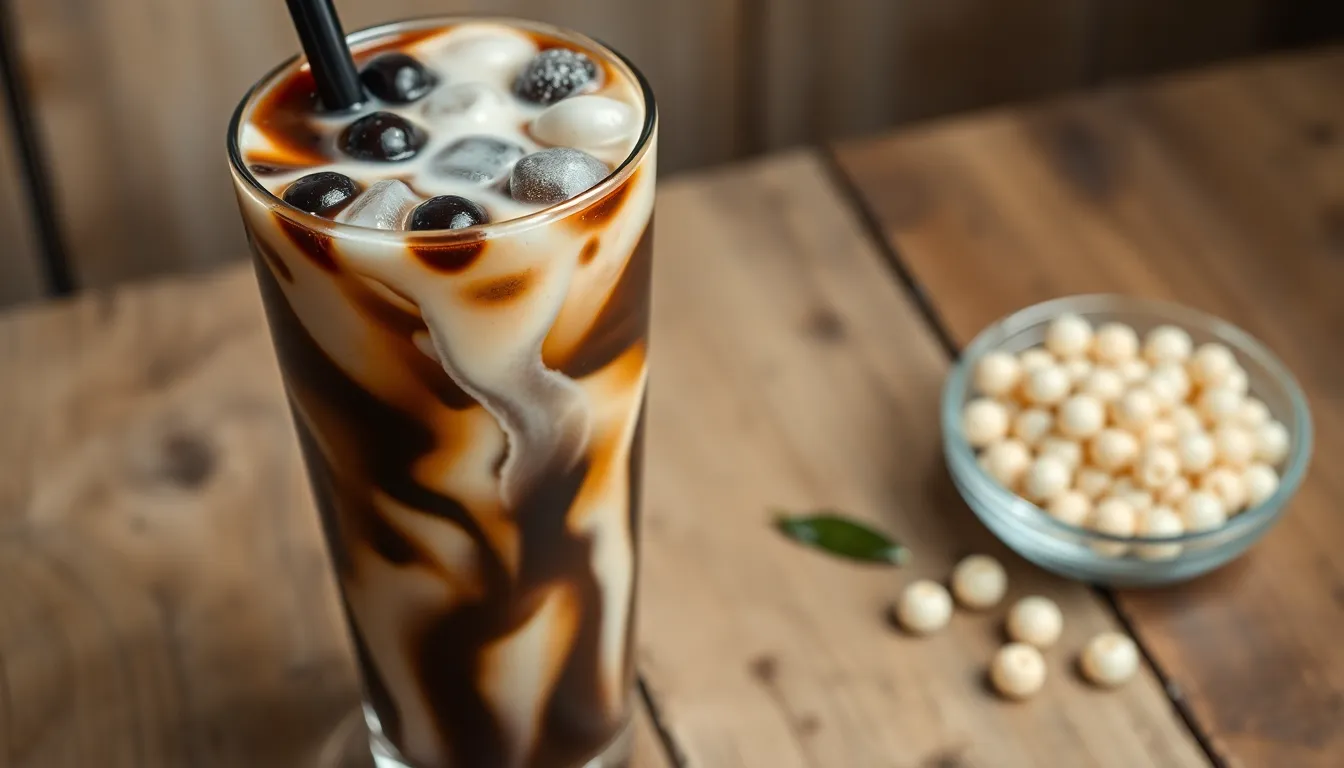
We’re starting with the foundation of all milk teas — a rich and creamy classic black milk tea that delivers the perfect balance of bold tea flavor and smooth dairy richness. This traditional recipe serves as our gateway to mastering the art of milk tea preparation at home.
Ingredients
For the Base Tea:
- Black tea (bags or loose leaf): 2–3 teaspoons or 2 tea bags
- Water: 2–4 cups
- Milk, milk creamer, or half-and-half: ¼–½ cup (adjust to taste)
- Sweetener (sugar, brown sugar, honey, or simple syrup): 1–2 tablespoons (adjust to taste)
Optional Add-ins:
- Tapioca pearls (boba): ½–¾ cup dried pearls
- Ice cubes for serving cold
Instructions
Step 1: Prepare Boba (Optional)
Bring a large pot of water to a rolling boil. Add tapioca pearls and stir immediately to prevent sticking. Simmer for 30 minutes while stirring occasionally. Drain the pearls and rinse with cold water. Soak the cooked boba in simple syrup to enhance flavor and maintain texture.
Step 2: Brew the Tea Base
Boil 2–4 cups of filtered water in a saucepan. Remove from heat and add your black tea bags or loose leaf tea. Steep for 4–5 minutes to extract maximum flavor without creating bitterness. Remove tea bags or strain loose leaves and allow the concentrated tea to cool slightly.
Step 3: Create the Sweetener Base
Dissolve your chosen sweetener in a small amount of hot water until completely mixed. We recommend starting with 1 tablespoon and adjusting based on your preference.
Step 4: Combine and Mix
Pour the brewed tea into a glass or cocktail shaker. Add your prepared milk or creamer along with the dissolved sweetener. Stir vigorously or shake well to create a uniform mixture with proper incorporation.
Step 5: Final Assembly
Place cooked boba pearls in the bottom of your serving glass if using. Add ice cubes for a refreshing cold version. Pour the prepared milk tea over the boba and ice. Serve immediately while the flavors are at their peak.
Prep Time and Cook Time
| Component | Time Required |
|---|---|
| Boba Cooking | 30 minutes active + 30 minutes resting |
| Tea Brewing | 5 minutes |
| Assembly | 5 minutes |
| Total Time (with boba) | 60-70 minutes |
| Total Time (without boba) | 10-15 minutes |
The beauty of this classic recipe lies in its flexibility — we can easily customize the milk ratio and sweetness level to match our personal taste preferences. Using filtered or spring water significantly enhances the tea’s natural flavors while preventing any unwanted mineral tastes from affecting our final product.
Thai Iced Tea Recipe
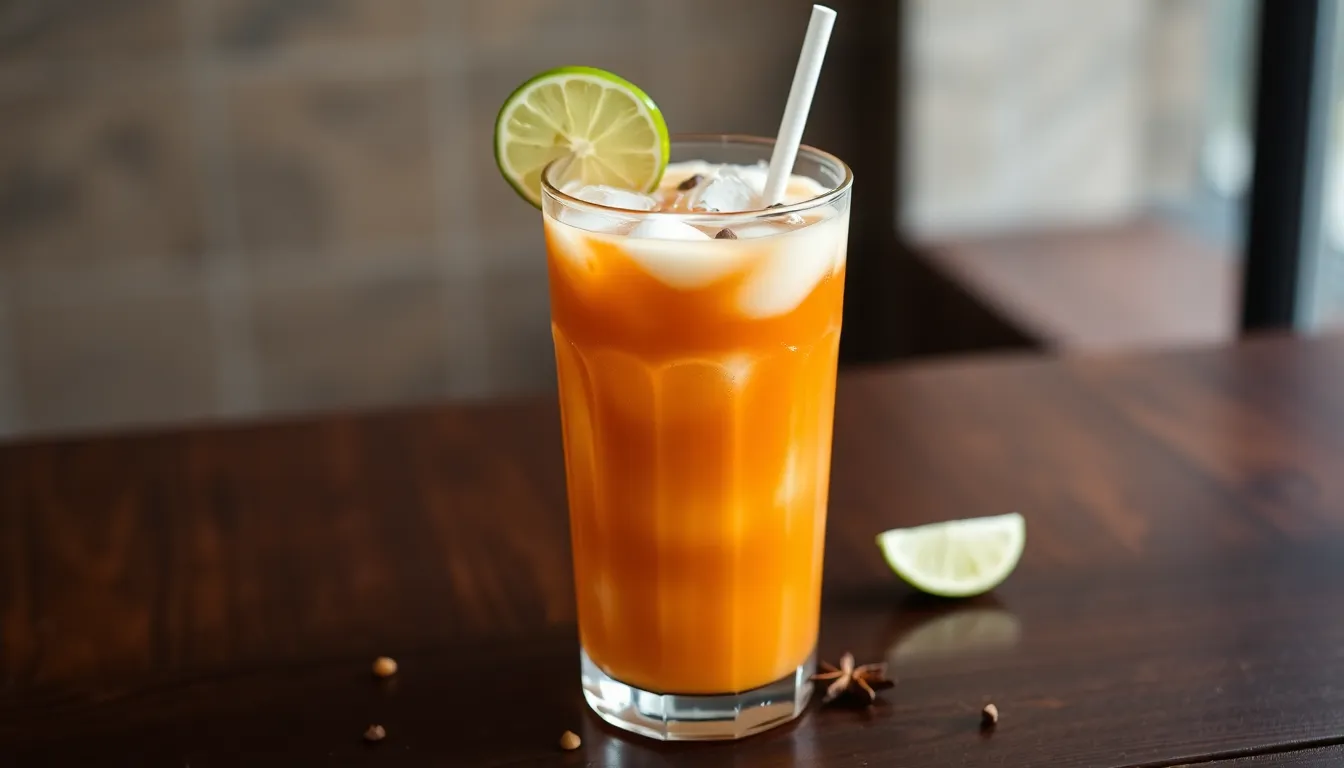
We love this vibrant orange-colored Thai iced tea for its perfect balance of strong tea flavor and creamy sweetness. This refreshing beverage brings authentic Thai café flavors directly to your kitchen.
Ingredients
For the Tea Base:
- 1 cup (80 g) Thai tea mix or 4 organic black tea bags
- 4 cups (960 ml) water
- 3/4 cup (150 g) granulated sugar
- 2 anise stars (optional)
- 1 green cardamom pod (optional)
- 2 whole cloves (optional)
For Serving:
- 3/4 cup (180 ml) half and half
- Ice cubes
- Sweetened condensed milk (alternative option)
- Coconut milk (dairy-free alternative)
- Whole milk (lighter option)
Instructions
Step 1: Prepare the Tea Concentrate
Combine Thai tea mix and water in a medium saucepan. Add granulated sugar and optional spices if using. Heat the mixture over medium heat until the sugar completely dissolves.
Step 2: Steep the Tea
Allow the tea to steep for 15 minutes until it develops a rich dark color. The longer steeping time ensures maximum flavor extraction from the tea leaves.
Step 3: Strain and Cool
Strain out all tea leaves and spices using a fine mesh strainer. Transfer the concentrated tea to the refrigerator and chill for at least one hour until completely cold.
Assembly and Serving
Step 1: Prepare the Glasses
Fill tall glasses with ice cubes until they reach about two-thirds full. The generous amount of ice keeps the drink refreshingly cold.
Step 2: Add the Tea
Pour the chilled tea concentrate over the ice in each glass. Leave room at the top for the milk component.
Step 3: Create the Signature Look
Slowly pour your chosen milk over the back of a spoon to create distinct layers. We recommend half and half for the most authentic flavor and richest texture.
Step 4: Final Touches
Gently stir the layers together just before drinking or leave layered for visual appeal. Serve immediately with wide straws for the best drinking experience.
Matcha Milk Tea Recipe

Matcha milk tea offers a sophisticated twist on traditional milk tea with its earthy green tea flavor and vibrant emerald color. We’ll guide you through creating this antioxidant-rich beverage that perfectly balances the grassy notes of matcha with creamy sweetness.
Ingredients
- 1 tsp matcha powder
- 3 tbsp hot water
- 1-2 tbsp honey or sweetener of choice
- 1 cup unsweetened almond milk or milk of choice
Instructions
Prepare Matcha: Sift matcha powder into a mug using a small sieve. Pour in the hot water and whisk with a matcha whisk until smooth and frothy.
Heat Milk: Warm the milk in a steamer or small saucepan on the stove until steaming but not boiling.
For Hot Matcha Milk Tea: Add honey to the mug with prepared matcha. Pour in the steamed milk and stir gently to combine. Serve immediately while hot.
For Iced Matcha Milk Tea: Stir honey and 1/4 cup of milk into the prepared matcha mixture. Chill for 15 minutes in the refrigerator. Fill a glass with ice and add the remaining milk. Pour the chilled matcha mixture over the top and stir before serving.
Whisking Technique
Use a matcha whisk to combine matcha powder and hot water for 10-15 seconds until the mixture becomes frothy and well incorporated. Rotate your wrist to create a zig-zag motion with the whisk rather than circular stirring.
We recommend whisking vigorously to eliminate any lumps and achieve the signature foam layer that enhances both texture and presentation. For a creamier version, increase the milk quantity or add non-dairy creamer. Adding tapioca pearls or boba creates a textured drink similar to bubble tea for those seeking additional variety.
Taro Milk Tea Recipe
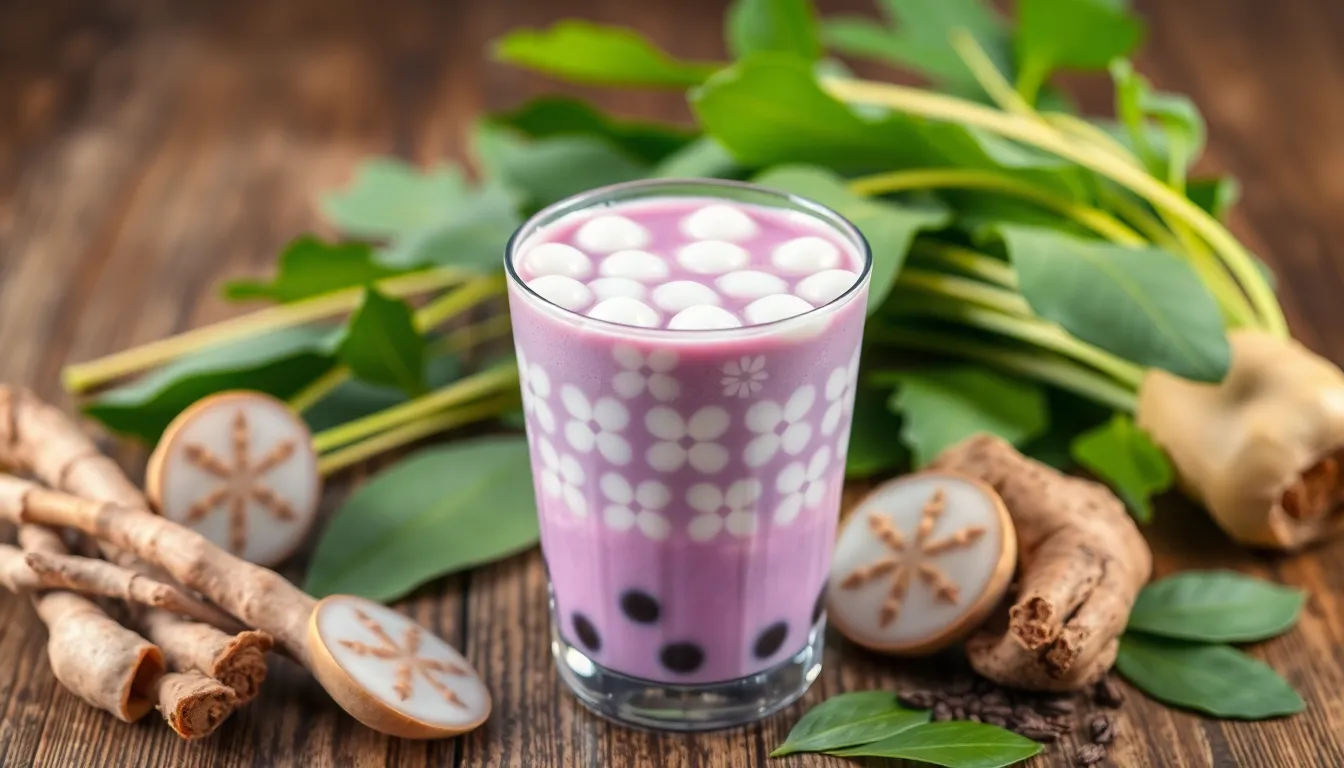
We love the creamy purple hue and subtly sweet nutty flavor that makes taro milk tea one of the most beloved variations in the milk tea industry. This delightful beverage combines the earthy taste of taro root with smooth milk and your choice of tea base.
Ingredients
- 2-4 tablespoons taro powder (adjust based on desired intensity)
- 1 green tea bag or black tea bag
- 1 cup milk (dairy or non-dairy options work well)
- 1/2 cup boba pearls (tapioca pearls)
- Hot water (1/2 to 1 cup for brewing tea)
- Ice cubes
- Sweetener of choice: simple syrup, sweetened condensed milk, honey, or sugar (optional)
Instructions
Step 1: Brew the Tea Base
Steep your tea bag in 1/2 to 1 cup of hot water for 4-5 minutes to create a strong tea concentrate. Remove the tea bag and allow the tea to cool completely before proceeding.
Step 2: Prepare the Tapioca Pearls
Cook the boba pearls according to package instructions or boil them in water with brown sugar to create a flavorful syrup coating. Drain and set aside once they reach the desired chewy texture.
Step 3: Create the Taro Milk Mixture
Whisk the taro powder thoroughly with milk until completely dissolved and no lumps remain. We recommend using a frothing wand or whisk to achieve a smooth consistency and prevent any grainy texture.
Step 4: Assemble Your Drink
Place the cooked boba pearls in the bottom of your serving cup. Add ice cubes to fill about one-third of the cup. Pour in the cooled tea concentrate followed by the taro milk mixture.
Step 5: Adjust and Serve
Taste your taro milk tea and add sweetener if desired. Stir gently to combine all ingredients and enjoy immediately with a wide straw.
Taro Preparation
Fresh taro root offers the most authentic flavor when you have time for extra preparation. Boil peeled taro root until tender then blend it into a smooth paste for a more natural taste compared to powder.
Taro powder provides convenience and consistent results for quick preparation. Ensure you mix the powder thoroughly with milk to avoid any lumps that could affect the smooth texture we want in our finished drink.
We suggest experimenting with different milk types and tea bases to discover your preferred flavor combination. The amount of taro powder can be adjusted based on how intense you want the taro flavor to be in your final beverage.
Brown Sugar Milk Tea Recipe
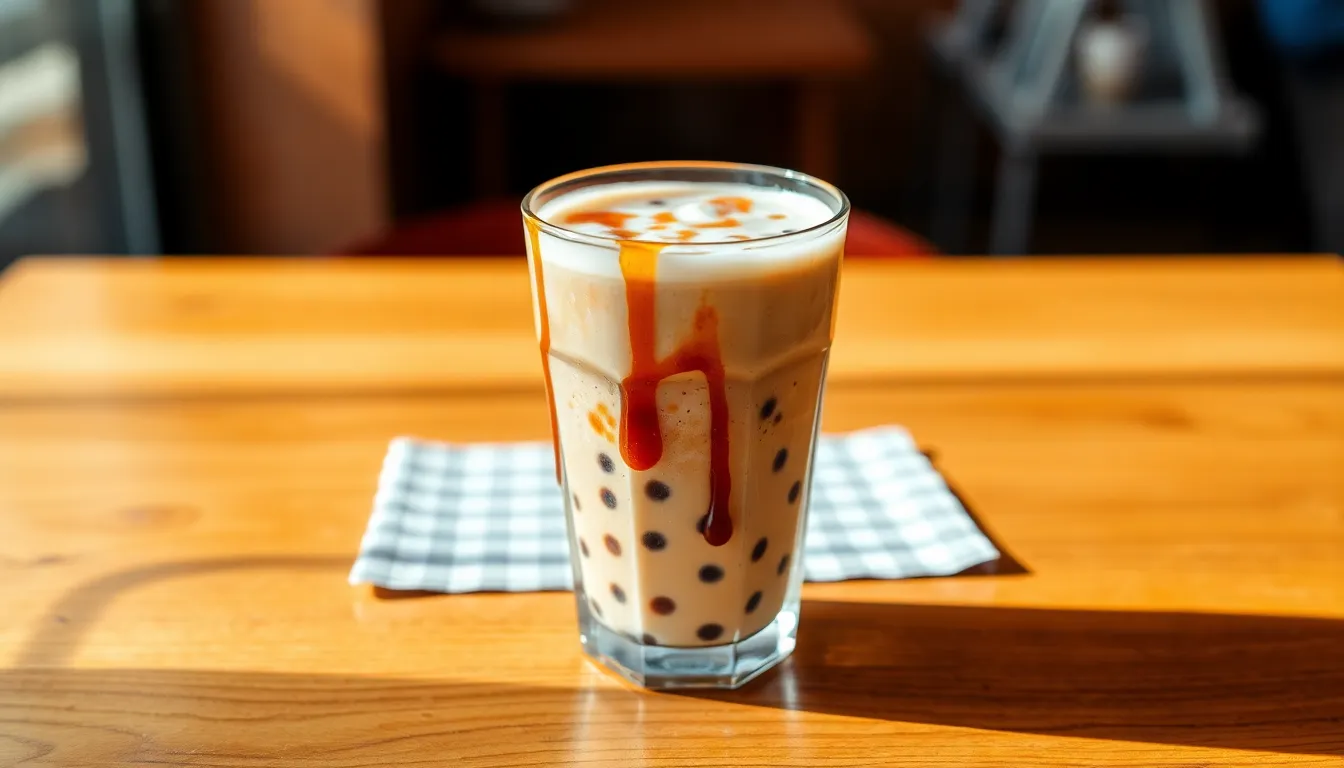
Brown sugar milk tea stands out as one of the most indulgent variations in the milk tea family. The rich caramel notes from brown sugar create a luxurious drinking experience that rivals premium café offerings.
Ingredients
Milk Tea Base
- 6 cups milk
- 2 tablespoons loose black tea leaves (or 4 tea bags)
- 3 tablespoons light brown sugar
Brown Sugar Syrup
- 2 cups brown sugar
- 2 cups water
Boba Pearls
- 1 cup tapioca flour
- ⅓ cup water
- ½ cup brown sugar
Instructions
We begin by preparing all components separately before bringing them together. The brown sugar syrup serves as both a flavor enhancer and visual element in this recipe. Creating fresh boba pearls ensures optimal texture and taste that store-bought alternatives cannot match.
Brown Sugar Syrup Preparation
Combine 2 cups of brown sugar and 2 cups of water in a medium saucepan. Bring the mixture to a rolling boil over medium-high heat. Reduce heat to low and allow the mixture to simmer until the sugar completely dissolves and the syrup develops a rich amber color. This process typically takes 8-10 minutes. Set the syrup aside to cool while we prepare the remaining components.
For the boba pearls combine ⅓ cup of water and ½ cup of brown sugar in a small saucepan. Simmer the mixture over medium heat until the sugar dissolves completely. Add 1 tablespoon of tapioca flour to the hot syrup and stir vigorously until fully incorporated. Gradually add the remaining tapioca flour while stirring continuously to form a cohesive dough. Knead the dough on a clean surface until smooth and pliable. Flatten the dough into a sheet approximately ¼ inch thick. Cut the sheet into small squares and roll each piece between your palms to form uniform pearls. Boil the pearls in water for 15-20 minutes until they float to the surface and achieve a chewy consistency.
Assembly and Layering
Steep the black tea leaves in 4 cups of hot water heated to 200°F for 3-5 minutes. Strain the tea leaves completely and discard them. Mix the brewed tea with milk and light brown sugar while the tea remains warm to ensure proper dissolution. Allow the milk tea mixture to cool to room temperature before proceeding with assembly.
Add ice cubes to tall serving glasses filling them approximately one-third full. Pour 2-3 tablespoons of brown sugar syrup into each glass creating a base layer. Slowly pour the cooled milk tea over the back of a spoon to create distinct layers. Add the prepared boba pearls to each glass using a large spoon. Drizzle additional brown sugar syrup along the inner walls of the glass for visual appeal. Serve immediately with wide straws to accommodate the boba pearls.
Bubble Tea (Boba) Milk Tea Recipe
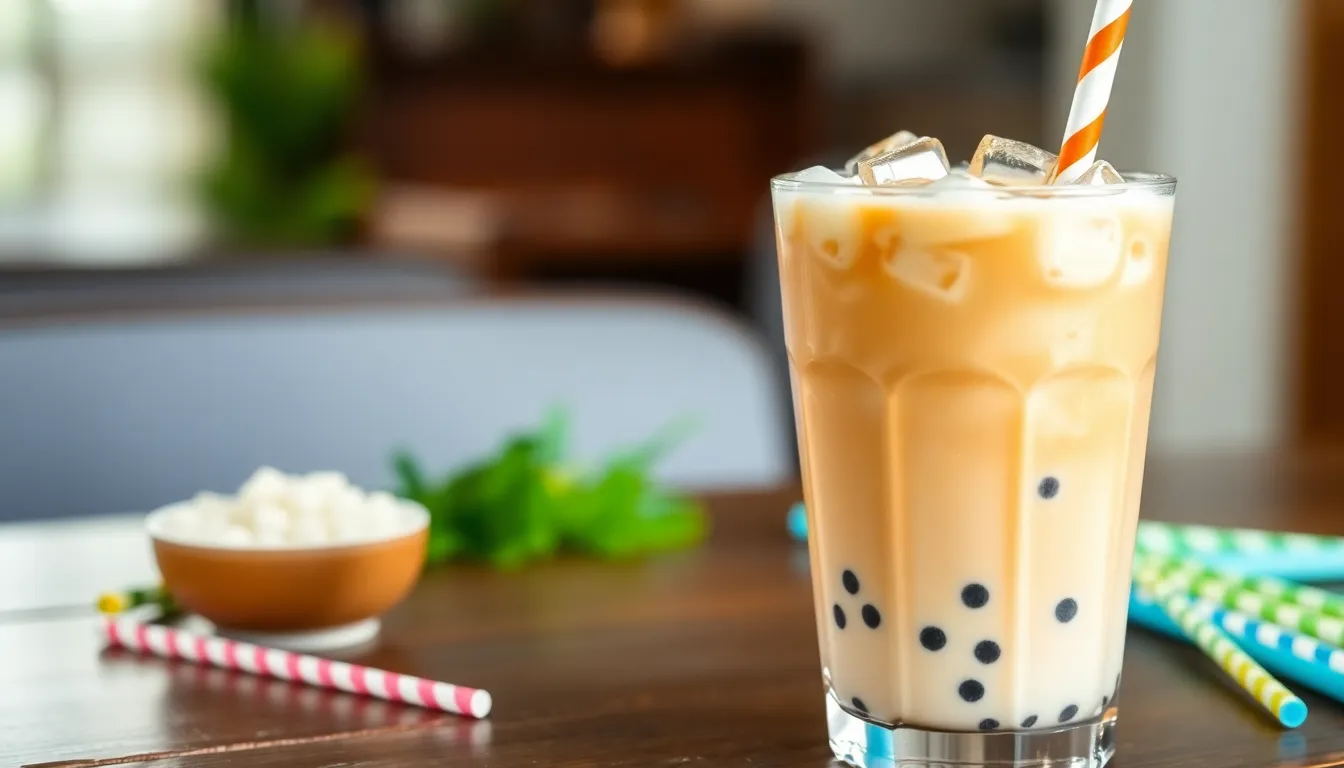
Bubble tea brings together the perfect balance of creamy milk tea and chewy tapioca pearls for an irresistible treat. We’ll guide you through creating this beloved Taiwanese beverage that has captured hearts worldwide.
Ingredients
Tea Base:
- 8 bags of black tea or 3 tablespoons loose-leaf black tea
- 4 cups boiling water
Milk Component:
- 1 cup whole milk or non-dairy milk (almond, coconut)
Sweetener:
- 1/2 cup water
- 1/2 cup sugar (for simple syrup)
- 1/4 cup brown sugar
- 2 tablespoons hot water (for brown sugar syrup)
Tapioca Pearls:
- 3/4 cup quick-cooking tapioca pearls
- Additional water for boiling
Instructions
Start by brewing your tea base with the black tea bags or loose-leaf tea in 4 cups of boiling water. Steep the tea for 5 to 10 minutes depending on how strong you prefer your flavor profile. Remove the tea bags or strain the loose-leaf tea using a fine colander or coffee filter to ensure a smooth liquid. Allow the brewed tea to cool to room temperature before proceeding with assembly.
Prepare your simple syrup by combining 1/2 cup water with 1/2 cup sugar in a small saucepan. Heat the mixture over medium heat until the sugar completely dissolves. Set aside to cool completely before using in your bubble tea preparation.
Tapioca Pearl Preparation
Bring a large pot of water to a rolling boil and add the 3/4 cup of quick-cooking tapioca pearls. Cook the pearls according to package instructions for approximately 5 minutes until they float to the surface. Remove from heat and rinse the cooked pearls immediately with cold water to stop the cooking process.
Create a brown sugar syrup by mixing 1/4 cup brown sugar with 2 tablespoons hot water until fully dissolved. Place the cooked tapioca pearls in this syrup to marinate while you prepare the remaining components. This marinating process enhances the pearls’ flavor and prevents them from sticking together.
Final Assembly
Add 1 cup of the cooled brewed tea into each serving glass. Pour in 1 1/2 tablespoons of milk and 1 1/2 tablespoons of simple syrup to each glass. Adjust these measurements according to your taste preferences for creaminess and sweetness.
Spoon 2 to 3 tablespoons of the marinated tapioca pearls along with some of their syrup into each glass. Stir the mixture well to combine all components evenly. Serve immediately at room temperature or add ice cubes for a refreshing chilled version that’s perfect for warm weather enjoyment.
Chai Milk Tea Recipe
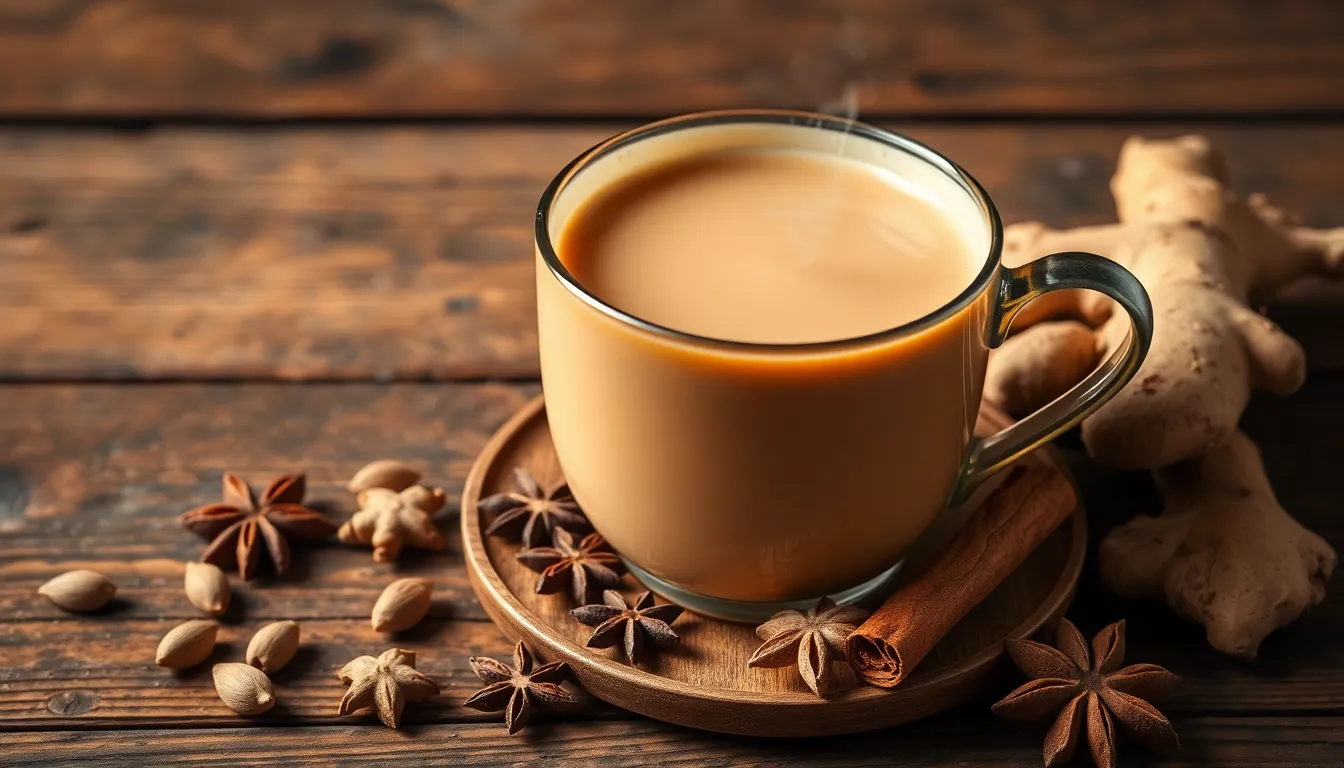
We journey into the aromatic industry of chai milk tea where traditional Indian spices create a warming beverage that balances bold flavors with creamy comfort. Our authentic chai recipe transforms simple ingredients into a soul warming drink that rivals the best tea houses.
Ingredients
- 1 ½ cups water
- 2-3 black tea bags
- 1 inch fresh ginger, sliced
- 2-3 whole cardamom pods
- 6 whole cloves
- 2 cinnamon sticks, broken into pieces
- 1 teaspoon whole peppercorns
- 1 ½ cups milk (whole, 2%, skim, or non-dairy milk)
- 2 teaspoons sugar (or to taste)
- Optional: honey or brown sugar for extra sweetness
Instructions
Step 1: Boil Water
Pour 1 ½ cups water into a large saucepan and bring to a rolling boil over medium-high heat.
Step 2: Add Spices
Drop sliced ginger, whole cardamom pods, cloves, broken cinnamon sticks, and whole peppercorns into the boiling water. Watch as aromatic steam begins to rise from the mixture.
Step 3: Simmer Spices
Reduce heat to medium-low and allow the spices to simmer for 5 minutes. The water transforms into a fragrant spice-infused base that forms the foundation of our chai.
Step 4: Add Tea
Place black tea bags into the spice-infused water and continue simmering for 3-4 minutes. The tea darkens to a rich amber color as it extracts maximum flavor.
Step 5: Prepare Milk
Heat milk in a separate saucepan over medium heat until steaming hot but not boiling. Alternatively, microwave the milk in 30-second intervals until hot.
Step 6: Combine and Sweeten
Strain the tea mixture through a fine-mesh strainer into large cups, discarding the used spices and tea bags. Pour the hot milk into the strained tea and add sugar to taste, stirring until dissolved.
Step 7: Serve
Serve immediately while hot, garnishing with additional cinnamon sticks or cardamom pods if desired.
Spice Blend Preparation
Lightly crush whole spices using a mortar and pestle before adding them to the water for more intense flavor release. This technique breaks the spice exteriors and allows essential oils to infuse more readily into the liquid. Adjust spice quantities according to your preference for heat and aromatic intensity. For a creamier texture, increase the milk ratio or add a splash of half-and-half. Experiment with vanilla extract or different tea varieties to create your signature chai blend.
Hong Kong Style Milk Tea Recipe
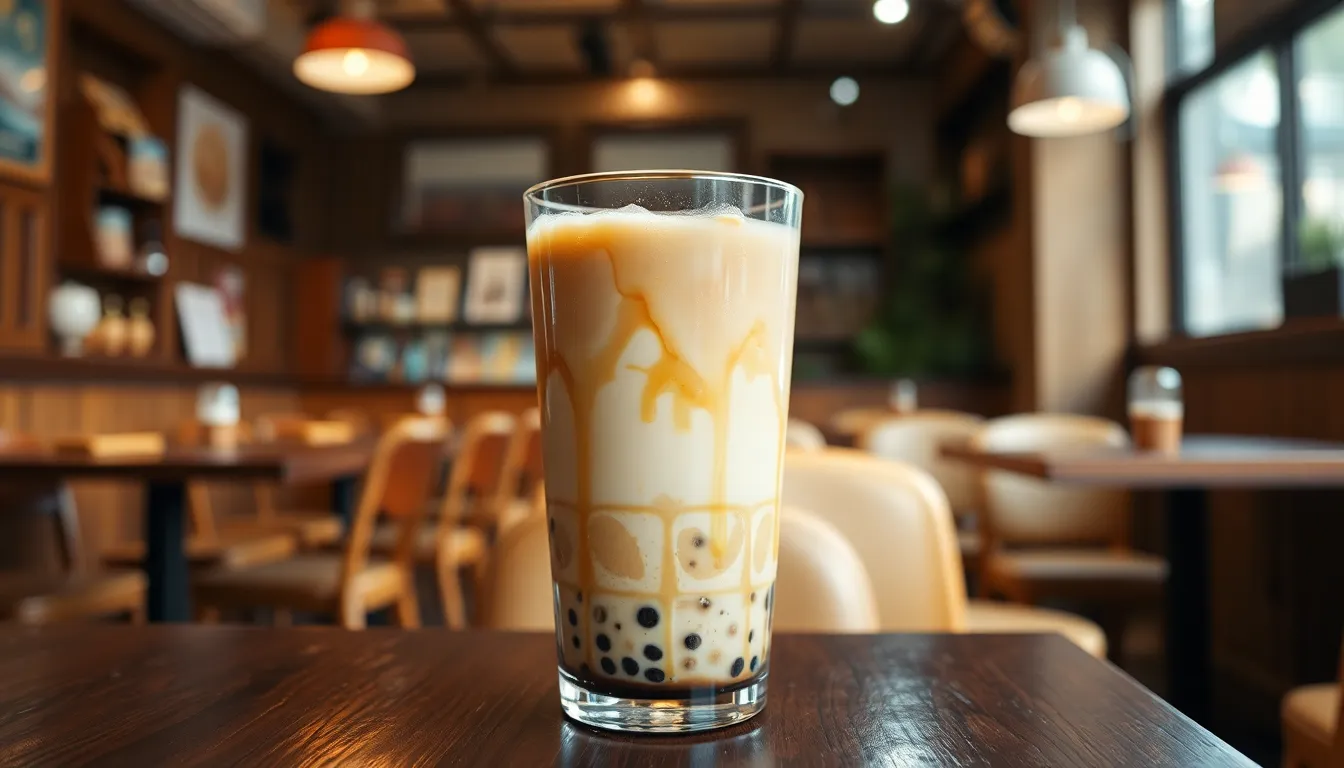
Hong Kong style milk tea represents the perfect marriage of robust black tea and creamy milk that creates a silky smooth beverage beloved across the region. We’ll guide you through this traditional recipe that delivers the authentic café experience right in your kitchen.
Ingredients
For the tea base:
- 10 tablespoons black tea blend (Ceylon, Assam, or orange pekoe mixed) or 2-3 tea bags for single serving
- 6 cups filtered water (1.4L, reduces to approximately 4½ cups brewed tea)
- 1 cup water for single serving preparation
For the milk mixture:
- ⅓ cup evaporated milk per serving (315 ml total for 4 servings)
- 1-2 tablespoons sweetened condensed milk (adjust to taste)
- 1 teaspoon sweetened condensed milk per serving as base sweetener
Optional additions:
- Sugar or sugar syrup for extra sweetness
- Fine cheesecloth for traditional straining
- Ice cubes for cold version
Instructions
Prepare the Tea Base
Bring 6 cups of filtered water to a rolling boil in a large saucepan. Add your black tea blend and maintain the boil for 6-15 minutes depending on your preferred strength. Stronger brewing creates the bold foundation essential for authentic Hong Kong milk tea.
Strain the hot tea through a fine-meshed strainer lined with cheesecloth to achieve the signature “silk stocking” smoothness. Traditional Hong Kong tea shops use specialized nylon or white cotton sock filters that create this silky texture. Remove and discard the used tea leaves completely.
Assemble the Milk Tea
For hot milk tea, pour the freshly brewed tea into your serving cup. Stir in sweetened condensed milk first to ensure proper dissolution. Add evaporated milk gradually while stirring to create the perfect creamy consistency.
For iced milk tea, fill a glass with ice cubes first. Pour the cooled black tea base over the ice. Add sweetened condensed milk and stir thoroughly before topping with evaporated milk for layered presentation.
Tea Pulling Technique
Master the Traditional Pull
Professional Hong Kong tea masters use a “pulling” technique that involves pouring the hot brewed tea between two containers from a important height. This aerates the tea while cooling it slightly and enhances the overall smoothness of the final drink.
Achieve Perfect Straining
Use a fine-meshed strainer or multiple layers of cheesecloth to create the silky texture that defines authentic Hong Kong milk tea. The straining process removes any remaining tea particles and creates the smooth mouthfeel that distinguishes this style from other milk teas.
| Tea Brewing Statistics | Measurement |
|---|---|
| Water to tea ratio | 6 cups water to 10 tablespoons tea |
| Brewing time | 6-15 minutes |
| Final tea yield | 4½ cups brewed tea |
| Evaporated milk per serving | ⅓ cup (80ml) |
| Condensed milk per serving | 1-2 tablespoons |
Adjust the milk ratios according to your preference with more condensed milk adding sweetness and more evaporated milk providing creaminess. Water quality significantly impacts the final taste so we recommend using filtered water for optimal results.
Hot vs. Iced Milk Tea Preparation
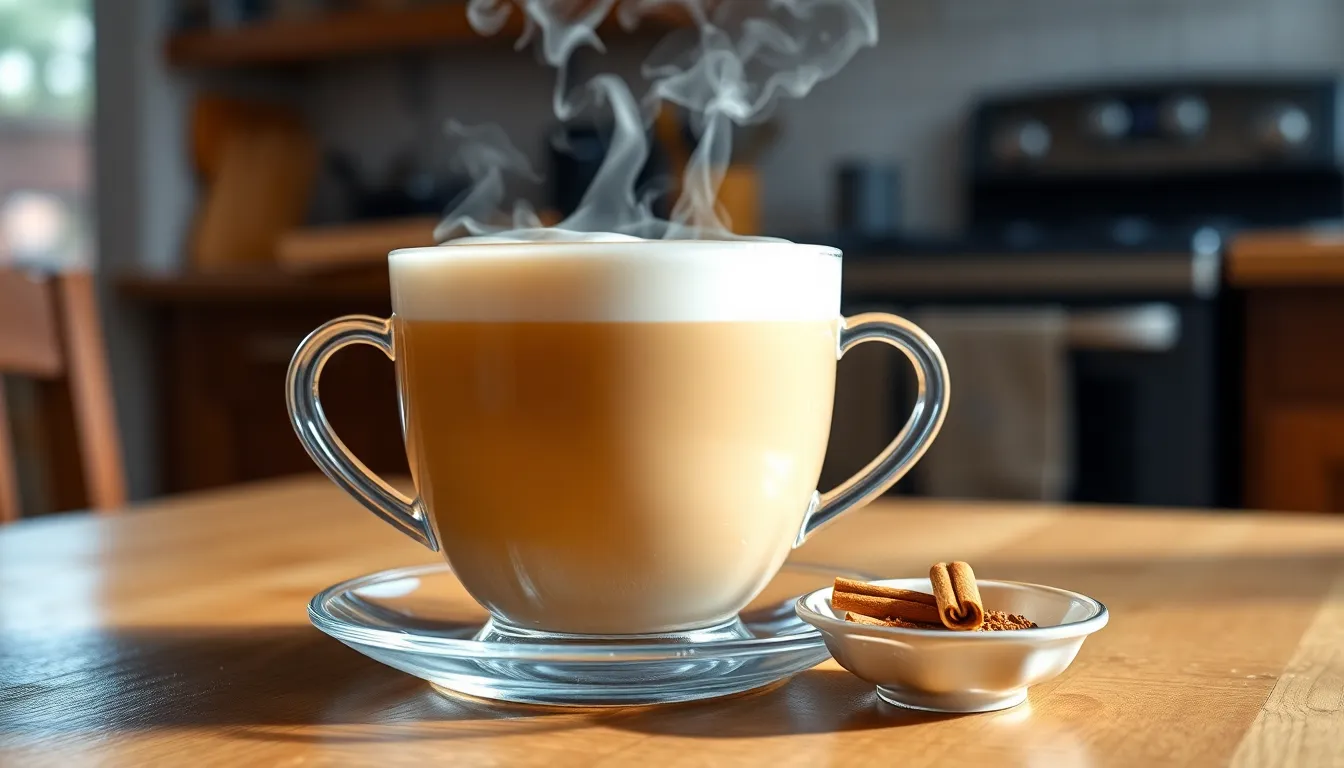
The method we choose for preparing milk tea significantly impacts both the flavor concentration and overall drinking experience. Temperature affects how tea compounds extract and how ingredients blend together to create distinct taste profiles.
Hot Milk Tea Method
We start by gathering our essential ingredients for this traditional preparation:
- 1 cup of milk
- 2 teaspoons of tea powder or black tea leaves
- 3 teaspoons of sugar
- Optional: spices like ginger, mint, cinnamon, or cardamom
Begin by boiling water in a saucepan over medium-high heat. Add sugar and tea powder to the boiling water, then continue boiling for 3-4 minutes to ensure proper extraction. Pour in the milk and maintain a steady boil until bubbles start to rise, which typically takes about 6-7 minutes. Strain the mixture through a fine mesh strainer into serving cups to remove any tea particles. Serve immediately while hot to enjoy the full aromatic experience.
The boiling process allows the tea to fully infuse with the milk while the heat helps dissolve sugar completely. We can customize this base recipe by incorporating warming spices during the initial boiling stage for enhanced flavor complexity.
Iced Milk Tea Method
Our iced version requires these exact ingredients for optimal results:
- ⅔ cup water
- 3 black tea bags or 1 tablespoon loose black tea
- 1 ⅓ cups cold whole milk
- ¼ cup heavy cream
- 2 tablespoons brown sugar
Start by boiling the water in a small saucepan. Remove from heat and steep the tea bags or loose tea for exactly 5 minutes to achieve the right strength. Remove the tea bags and stir in brown sugar until completely dissolved. Allow the tea mixture to cool to room temperature before proceeding.
Combine the cooled tea concentrate with cold whole milk and heavy cream in a pitcher. Stir thoroughly to ensure even distribution. Fill serving glasses with ice cubes and pour the milk tea mixture over the ice. Top with whipped cream if desired for an indulgent finish.
The cooling process prevents the milk from curdling when mixed with the tea concentrate. We recommend using brown sugar for iced versions as it adds depth and caramel notes that complement the cold serving temperature.
Make-Ahead Instructions and Storage
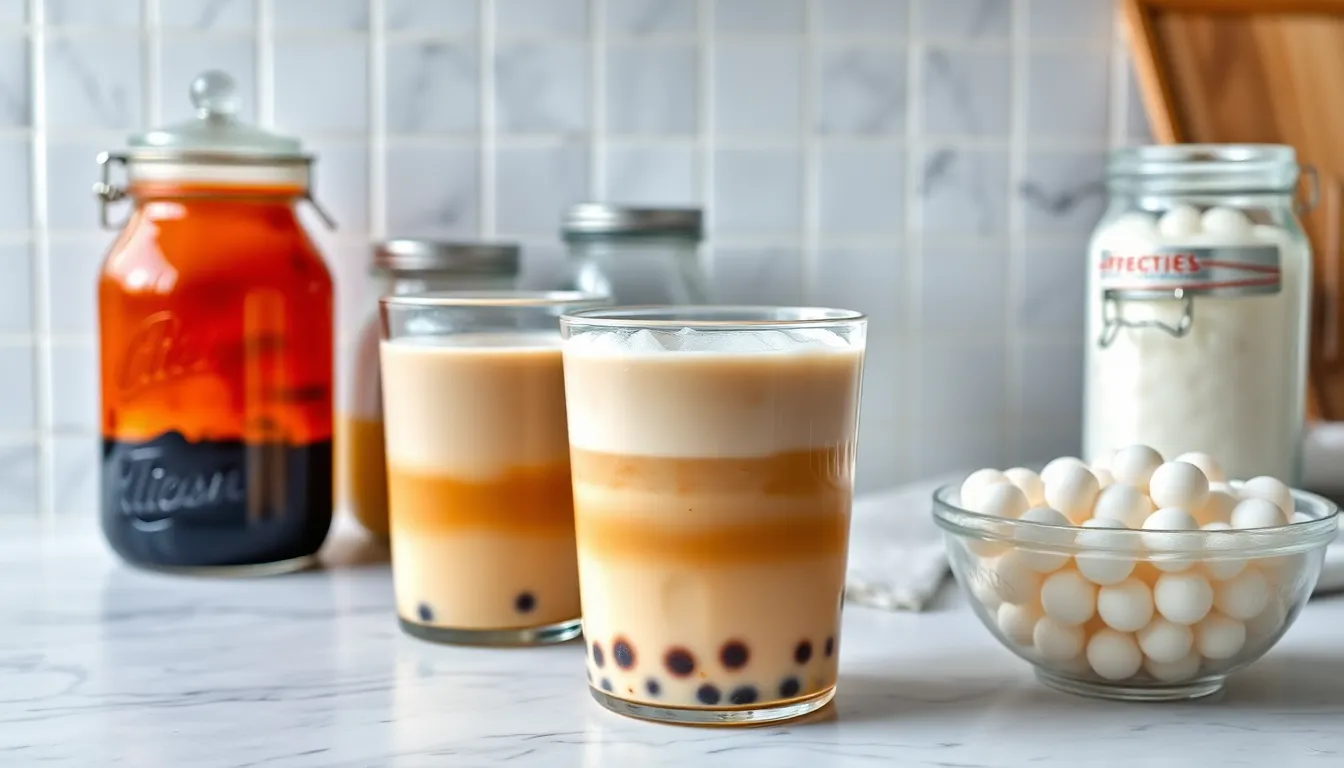
We understand that preparing milk tea can be time-consuming, so making components ahead of time saves precious minutes during busy days. Our make-ahead approach focuses on preparing individual elements separately to maintain optimal flavor and texture.
Tea Preparation
Hot Brew Method
We recommend steeping black tea according to recipe directions and allowing it to cool completely to room temperature. Store the cooled tea in a jar with a tight-fitting lid in the refrigerator for up to 2-3 days before using. This method gives us full control over the brewing strength and eliminates the need to wait for hot tea to cool when making iced versions.
Cold Brew Method
We prefer placing tea bags in cold or room temperature water and refrigerating overnight for a smoother preparation process. Strain the tea before use as this method yields a sweeter and less bitter base compared to hot brewing. Cold brewing eliminates the tannin bitterness that sometimes occurs with hot water extraction.
Tea Freezing Option
We can freeze brewed tea in ice cube trays for extended storage beyond the refrigerator timeframe. Thaw the tea cubes before incorporating them into our milk tea recipes for consistent results.
Syrup and Sweeteners
We make simple syrup or brown sugar syrup several days in advance to streamline our milk tea preparation. Store these sweeteners in small airtight containers in the refrigerator for up to 5 days. Adding sweeteners just before serving ensures the best flavor integration and prevents crystallization issues that can occur during storage.
Dairy and Non-Dairy Milk
We add fresh milk, cream, or non-dairy alternatives like almond, coconut, or oat milk only when ready to serve our milk tea. Never store milk tea with milk already mixed in as dairy products can sour and separate during refrigeration. For dairy-free options, we incorporate nondairy milk alternatives at the time of preparation to maintain food safety standards.
Tapioca Pearls (Boba)
We cook only the amount of boba needed for each serving since cooked pearls harden and lose their signature chewiness during storage. If storage becomes necessary, we keep cooked pearls with syrup in an airtight container in the refrigerator for up to 1 day maximum. Reheat stored boba in 30-second intervals in a microwave before serving to restore some texture. We avoid freezing boba as it completely ruins the desired chewy consistency.
General Storage Recommendations
We store all components separately in the refrigerator for best quality maintenance. Tea, syrup, and boba each require individual storage containers to prevent flavor transfer and maintain their distinct characteristics. Assembling drinks fresh ensures optimal taste and texture that rivals professional café standards. We do not recommend storing leftover mixed milk tea that includes dairy components due to rapid spoilage concerns.
| Component | Make Ahead Time | Storage Time in Fridge |
|---|---|---|
| Brewed Tea | 2-3 days | 2-3 days |
| Syrup | Several days | 5 days |
| Cooked Boba | Not recommended | 1 day (with syrup) |
| Mixed Milk Tea | Not recommended | Not recommended |
Tips for Perfect Milk Tea Every Time
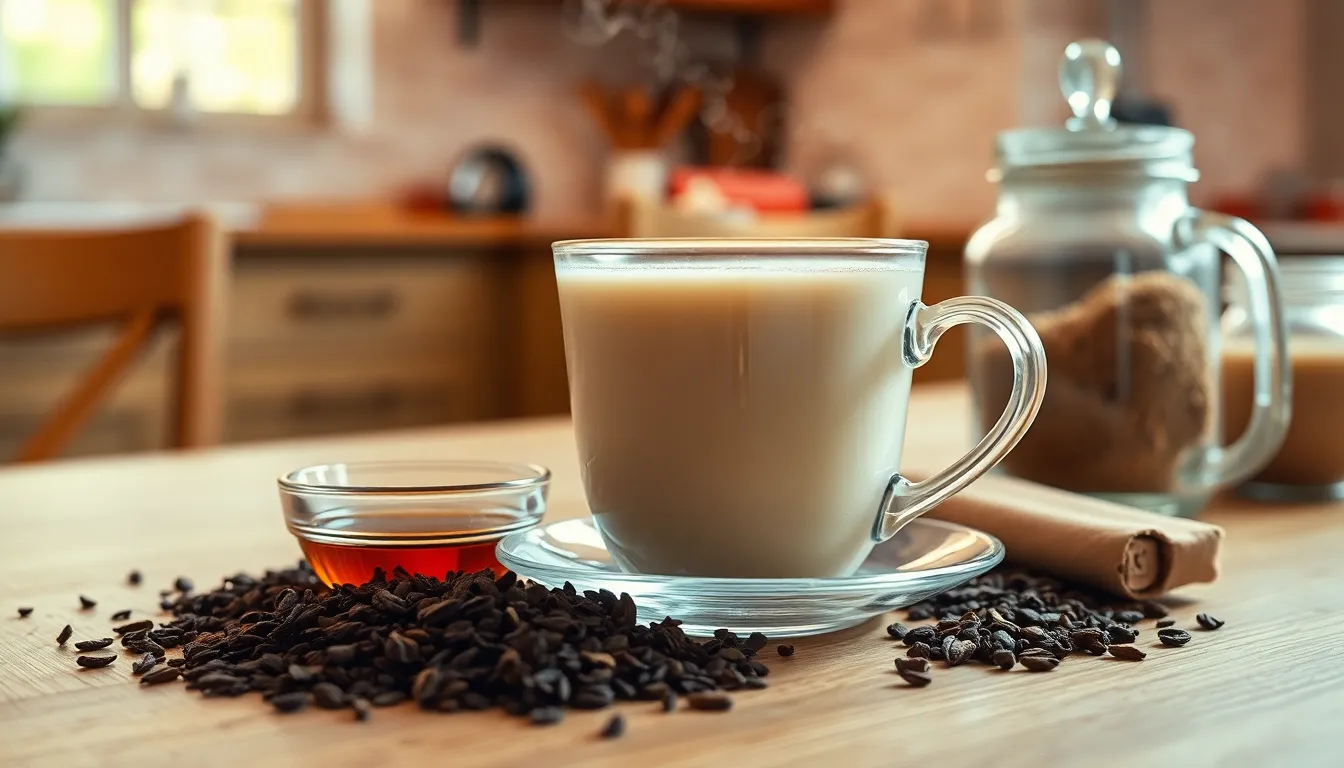
Mastering the art of milk tea requires attention to key details that transform a simple beverage into a café-quality experience. We’ve refined these essential techniques through extensive testing to ensure consistent results with every batch.
Start with Fresh Water Quality
Fresh or filtered water forms the foundation of exceptional milk tea. Impurities in tap water alter the delicate flavor balance and create off-tastes that mask the tea’s natural characteristics. We recommend using filtered water whenever possible to achieve the cleanest flavor profile.
Control Your Tea Steeping Time
Black tea requires precise timing to extract optimal flavor without bitterness. Steep loose tea leaves for 5 minutes or tea bags for the same duration to achieve the perfect strength. Over-steeping creates harsh tannins that overpower the milk’s creaminess.
Customize Sweetness Levels
Sweetener selection dramatically impacts your milk tea’s final taste profile. Sugar dissolves completely when added to hot tea, while honey provides subtle floral notes. Brown sugar creates deeper caramel flavors that complement robust black teas particularly well.
Experiment with Milk Varieties
Different milk types produce distinct textures and flavors in your finished beverage. Whole milk delivers rich creaminess, while heavy cream creates an indulgent texture perfect for special occasions. Non-dairy alternatives like oat milk or almond milk offer lighter options without sacrificing taste.
Add Flavorings Strategically
Spices transform basic milk tea into aromatic specialty drinks. Fresh ginger adds warming heat, while cinnamon provides sweet spice notes. Add these flavorings during the tea steeping process to ensure proper infusion throughout the liquid.
Temperature Control for Serving
Hot milk tea should reach serving temperature without boiling the milk, which prevents curdling and maintains smooth texture. For iced versions, allow the tea to cool completely before adding cold milk to prevent temperature shock that affects flavor integration.
Strain for Smooth Results
Proper straining removes tea particles and ensures silky smooth texture in your finished drink. Use fine-mesh strainers for loose leaf teas or remove tea bags completely before adding milk components.
Customization and Variations
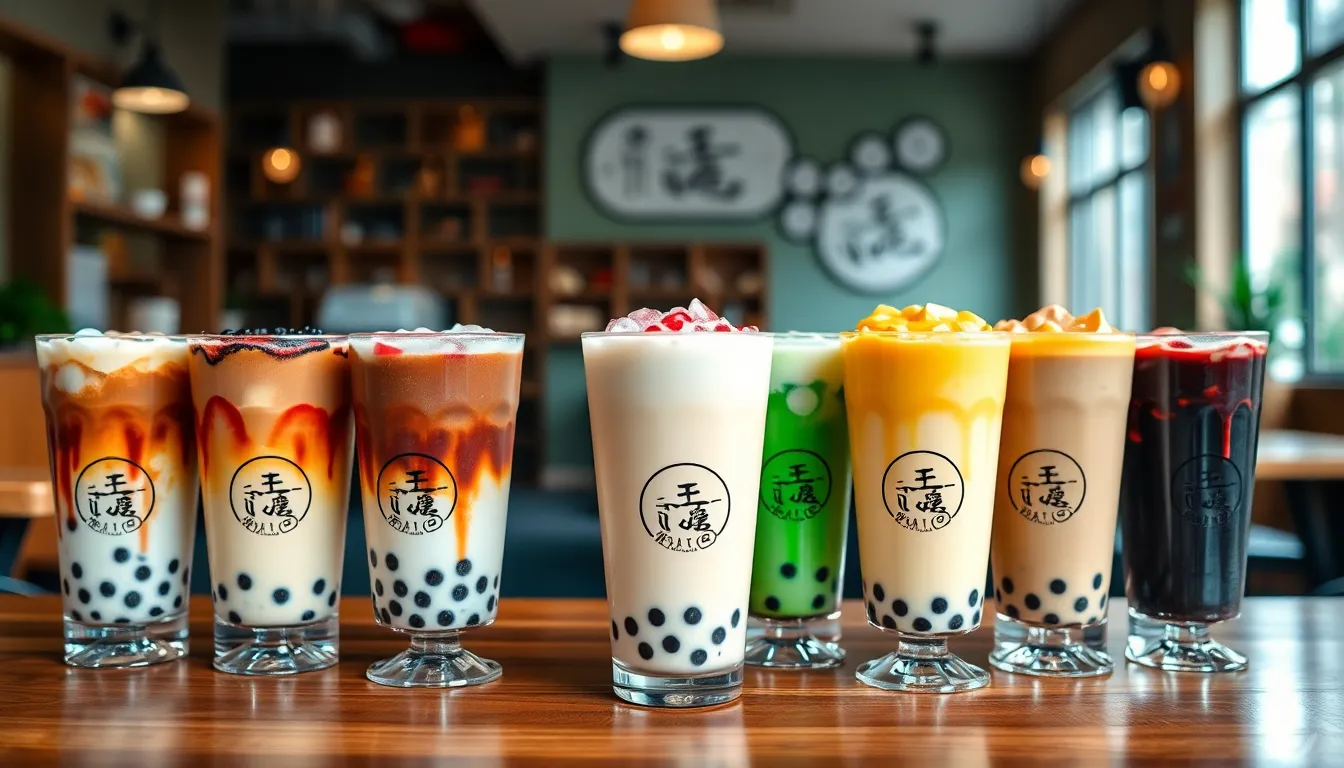
Milk tea offers endless possibilities for personalization, allowing us to create beverages that perfectly match our taste preferences. We can explore many variations by adjusting base teas, milk choices, sweeteners, and additional ingredients to create unique flavor profiles.
Tea Base Options
Different tea varieties provide distinct foundation flavors for our milk tea creations. Black tea remains the traditional choice, with exact varieties offering unique characteristics:
| Tea Type | Flavor Profile | Best For |
|---|---|---|
| Orange Pekoe | Bold, malty | Classic milk tea |
| Blue Lady Grey | Aromatic, citrusy | Hong Kong style |
| Earl Grey | Bergamot-infused | Sophisticated variations |
| Green Tea | Light, grassy | Matcha milk tea |
| Oolong | Complex, floral | Premium blends |
We can also experiment with chai blends, incorporating traditional spices like cardamom, cinnamon, and ginger for warming variations. Matcha powder creates vibrant green milk teas with earthy undertones, while jasmine tea adds delicate floral notes to lighter versions.
Milk Alternative Customizations
Our choice of milk dramatically impacts both texture and flavor development. Traditional whole milk provides rich creaminess, while evaporated milk creates the signature silky texture found in Hong Kong milk tea. Half and half produces beautiful swirls when combined with brown sugar syrups.
Dairy-free alternatives offer exciting customization opportunities:
- Coconut milk adds tropical sweetness and natural creaminess
- Almond milk provides nutty undertones with lighter texture
- Oat milk creates barista-quality foam and neutral flavor
- Soy milk offers protein richness with subtle bean notes
Sweetener Variations
We can customize sweetness levels using various options beyond standard sugar. Brown sugar creates rich caramel notes and attractive swirls when made into syrup. Condensed milk provides both sweetness and creaminess simultaneously, particularly effective in Vietnamese and Thai variations.
Natural alternatives include honey for floral sweetness, maple syrup for autumn flavors, and agave nectar for lighter sweetness profiles. Simple syrup allows precise sweetness control without altering flavor balance.
Texture and Add-In Options
Boba (tapioca pearls) transforms basic milk tea into bubble tea, providing chewy texture contrast. We cook these pearls with brown sugar syrup for enhanced sweetness and glossy appearance. Popping boba offers burst-in-your-mouth sensations with fruit flavors, while grass jelly provides refreshing, slightly herbal textures.
Other texture enhancers include:
- Pudding for creamy, custard-like additions
- Red beans for traditional Asian sweetness
- Coconut jelly for tropical chewiness
- Chia seeds for nutritional boost and unique texture
Spice and Flavor Enhancements
We can infuse additional complexity through spice additions during the steeping process. Traditional chai spices like cardamom pods, cinnamon sticks, and fresh ginger create warming beverages perfect for cooler weather. Star anise adds licorice notes, while cloves provide warming spice depth.
Flavored syrups offer another customization avenue, with options like vanilla, hazelnut, or seasonal flavors like pumpkin spice. We can also incorporate fruit purees for tropical variations or lavender for floral elegance.
These customization options allow us to create personalized milk tea experiences that rival professional café offerings while accommodating dietary restrictions and flavor preferences.
Conclusion
We’ve equipped you with everything needed to master milk tea at home. From understanding essential equipment and quality ingredients to exploring diverse recipes and customization options you now have the tools to create café-quality beverages in your own kitchen.
The beauty of homemade milk tea lies in its flexibility. Whether you prefer classic black tea blends spiced chai variations or trendy matcha creations you can adjust every element to match your taste preferences and dietary needs.
Start with our foundational recipes then experiment with different tea bases milk alternatives and flavor enhancers. With proper storage techniques and preparation methods you’ll save money while enjoying fresh personalized milk tea whenever the craving strikes.
Your journey into the industry of homemade milk tea begins now – grab your favorite tea and start brewing!
Frequently Asked Questions
What is milk tea and why is it so popular worldwide?
Milk tea is a beverage that combines tea with milk and sweeteners, originating from various cultures and evolving into an art form. Its popularity stems from diverse regional variations like Taiwan’s bubble tea, India’s chai masala, and Hong Kong-style milk tea. The drink offers endless customization possibilities and has transformed from a simple beverage into a trendy café staple enjoyed globally.
What equipment do I need to make café-quality milk tea at home?
Essential equipment includes tea strainers, infusers, measuring tools, milk frothers, and blenders. Quality materials are important for optimal results, while electric equipment provides convenience and consistency. Basic tools like measuring cups, fine-mesh strainers, and a good teapot or brewing vessel will help you achieve professional-quality results at home.
Which tea types work best for milk tea?
The three primary tea types for milk tea are black tea, Ceylon tea, and green tea. Black tea provides a robust, malty flavor perfect for traditional milk tea. Ceylon tea offers a bright, citrusy profile, while green tea (including matcha) creates lighter, more delicate flavors. Each type offers distinct characteristics suitable for different milk tea styles.
What type of milk should I use for the best milk tea?
Whole milk provides the richest, creamiest texture, while heavy cream creates an ultra-luxurious consistency. For lighter options, try 2% or skim milk. Non-dairy alternatives like oat milk, almond milk, or coconut milk work well for dietary restrictions. The milk choice significantly impacts both texture and flavor, so experiment to find your preference.
How do I properly store milk tea ingredients and prepared drinks?
Store tea leaves in airtight containers away from light and moisture. Keep syrups refrigerated for up to one month. Dairy milk should be used within its expiration date, while non-dairy alternatives last longer. Prepared tapioca pearls should be consumed within 4 hours. Store assembled drinks refrigerated for maximum 24 hours for best quality.
What’s the difference between hot and iced milk tea preparation?
Hot milk tea allows for stronger flavor concentration and better spice integration during brewing. Iced milk tea requires stronger tea concentration to account for dilution from ice. Temperature affects the overall drinking experience – hot versions emphasize aromatic qualities, while cold versions are refreshing and highlight sweetness balance.
How can I customize my milk tea to create unique flavors?
Customize by adjusting tea bases (black, green, oolong), milk types (dairy or non-dairy), sweeteners (brown sugar, honey, maple syrup), and add-ins like boba, pudding, or chia seeds. Experiment with spices during steeping, flavored syrups, or traditional chai spices. This flexibility allows you to create personalized drinks that match your taste preferences.
What are common mistakes to avoid when making milk tea?
Avoid over-steeping tea which creates bitterness, using poor-quality water, and improper temperature control. Don’t skip straining for smooth texture, and ensure proper sweetener dissolution. Avoid storing assembled drinks too long, mixing incompatible flavors, and using expired dairy products. Following proper brewing times and ratios is crucial for consistent results.
